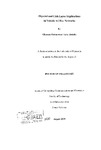Physical and Link Layer Implications in Vehicle Ad Hoc Networks
| dc.contributor.author | Abdalla, Ghassan Mohammed Taha | |
| dc.contributor.other | School of Engineering, Computing and Mathematics | en_US |
| dc.date.accessioned | 2011-05-10T10:48:47Z | |
| dc.date.available | 2011-05-10T10:48:47Z | |
| dc.date.issued | 2009 | |
| dc.identifier | Not available | en_US |
| dc.identifier.uri | http://hdl.handle.net/10026.1/331 | |
| dc.description.abstract |
Vehicle Ad hoc Networks (V ANET) have been proposed to provide safety on the road and deliver road traffic information and route guidance to drivers along with commercial applications. However the challenges facing V ANET are numerous. Nodes move at high speeds, road side units and basestations are scarce, the topology is constrained by the road geometry and changes rapidly, and the number of nodes peaks suddenly in traffic jams. In this thesis we investigate the physical and link layers of V ANET and propose methods to achieve high data rates and high throughput. For the physical layer, we examine the use of Vertical BLAST (VB LAST) systems as they provide higher capacities than single antenna systems in rich fading environments. To study the applicability of VB LAST to VANET, a channel model was developed and verified using measurement data available in the literature. For no to medium line of sight, VBLAST systems provide high data rates. However the performance drops as the line of sight strength increases due to the correlation between the antennas. Moreover, the performance of VBLAST with training based channel estimation drops as the speed increases since the channel response changes rapidly. To update the channel state information matrix at the receiver, a channel tracking algorithm for flat fading channels was developed. The algorithm updates the channel matrix thus reducing the mean square error of the estimation and improving the bit error rate (BER). The analysis of VBLAST-OFDM systems showed they experience an error floor due to inter-carrier interference (lCI) which increases with speed, number of antennas transmitting and number of subcarriers used. The update algorithm was extended to VBLAST -OFDM systems and it showed improvements in BER performance but still experienced an error floor. An algorithm to equalise the ICI contribution of adjacent subcarriers was then developed and evaluated. The ICI equalisation algorithm reduces the error floor in BER as more subcarriers are equalised at the expense of more hardware complexity. The connectivity of V ANET was investigated and it was found that for single lane roads, car densities of 7 cars per communication range are sufficient to achieve high connectivity within the city whereas 12 cars per communication range are required for highways. Multilane roads require higher densities since cars tend to cluster in groups. Junctions and turns have lower connectivity than straight roads due to disconnections at the turns. Although higher densities improve the connectivity and, hence, the performance of the network layer, it leads to poor performance at the link layer. The IEEE 802.11 p MAC layer standard under development for V ANET uses a variant of Carrier Sense Multiple Access (CSMA). 802.11 protocols were analysed mathematically and via simulations and the results prove the saturation throughput of the basic access method drops as the number of nodes increases thus yielding very low throughput in congested areas. RTS/CTS access provides higher throughput but it applies only to unicast transmissions. To overcome the limitations of 802.11 protocols, we designed a protocol known as SOFT MAC which combines Space, Orthogonal Frequency and Time multiple access techniques. In SOFT MAC the road is divided into cells and each cell is allocated a unique group of subcarriers. Within a cell, nodes share the available subcarriers using a combination of TDMA and CSMA. The throughput analysis of SOFT MAC showed it has superior throughput compared to the basic access and similar to the RTS/CTS access of 802.11. | en_US |
| dc.language.iso | en | en_US |
| dc.publisher | University of Plymouth | en_US |
| dc.title | Physical and Link Layer Implications in Vehicle Ad Hoc Networks | en_US |
| dc.type | Thesis | |
| dc.identifier.doi | http://dx.doi.org/10.24382/3200 |
Files in this item
This item appears in the following Collection(s)
-
01 Research Theses Main Collection
Research Theses Main


